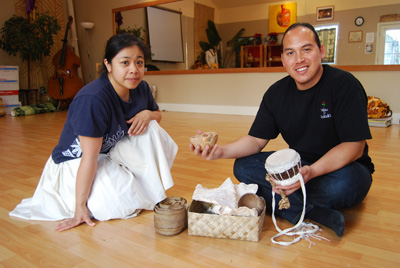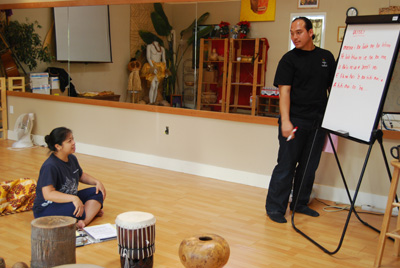 Editor’s Note: Master artist Kumu Hula Kawika Keikiali’ihiwahiwa Alfiche and apprentice Maka Aniciete are current participants in ACTA’s Apprenticeship Program, and have been working on the preservation of different types of chant, the tradition of hula pahu (dances associated with the shark-skinned drum) and the making of certain hula implements.
Editor’s Note: Master artist Kumu Hula Kawika Keikiali’ihiwahiwa Alfiche and apprentice Maka Aniciete are current participants in ACTA’s Apprenticeship Program, and have been working on the preservation of different types of chant, the tradition of hula pahu (dances associated with the shark-skinned drum) and the making of certain hula implements.
From the mind of the master: Aloha mai kakou (greetings all)! My name is Kawika Keikiali’ihiwahiwa Alfiche and I am the Kumu Hula (teacher of hula) of Halau o Keikiali’i, a traditional hula group based locally in South San Francisco, for 15 years now. I am a Kumu Hula as well as a Native Practitioner of all things Hawaiian, which involves: lei-making, native plants, land cultivation and harvest, crafts, implements, and art.
I am haumana (student) of Kumu Hula Rae Kahikilaulani Fonseca of Hilo, Hawai’i. His lineage of hula includes Uncle Henry Mo’ikeha Pa and Uncle George Lanakilakeikiahiali’i Naope who learned from many Kumu, including Mary Ahiena Kekuewa (Momma Fuji’i), Lokalia Montgomery and Thomas Hiona to name a few. Before I fell under Kumu Rae, I was haumana of Tiare Maka Olanolan-Clifford and Aunty Harriet Keahilihau- Spalding. I am part of the first ‘Uniki (traditional graduation for Kumu Hula) of Kumu Rae, who has been teaching for some 30 years.
As teachers, it is important to know the Kumu of our own Kumu because they are the guiding lights in our search for knowledge and whose flame burns brightly in our path of life through the hula. Without them, we would not exist as these lineages take us back to the beginning of Hula itself.
Not too long ago, learning hula would be mostly a one on one kind of learning – Kumu ia Haumana (master to apprentice). My Kumu, Rae Kahikilaulani Fonseca, actually lived with his Kumu (Uncle George Naope) for 3 years in his late teens so his learning was day and night. Sometimes Uncle George would get up in the middle of the night and be inspired to pass on some kind of lesson to Kumu Rae – a dance, a chant, or perhaps a style of lei making.
Today, hula is learned mostly in masses. Although this process of learning is fine, it often lacks the personal connection and the full attention of both the Kumu and Haumana. I have heard of some classes or workshops (in Japan of all places) having upwards of 1,000 participants with just one teacher. Wow! This is amazing to me as I try to envision the Kumu calling out corrections, “Hey you… 14th row back and 3rd one on the left, please lift your arm higher.” I am truly amazed. Either way, hula must be taught on every level – but especially on the master-apprentice level, which is a rarity in this day and age.
People often ask me how we continue hula here in San Francisco. My response is always that I have excellent Kumu and mentors, and I fly home to the Motherland [Hawai’i] as much as possible. At our halau in South San Francisco, my haumana are also involved with the cultivation of our small piece of land where we grow native plants that we use in dancing hula. Some of the plants are considered kinolau (vegetable bodies) of certain gods and goddesses. We pay particular attention with certain plants, especially that of one of our Hula goddesses, Laka. Some of these plants will be used in the lole (clothing), kupe’e and lei (adornments) of Maka Aniciete at her public Ho’ike (performance) at the completion of this Apprenticeship Program contract.
The ‘aina (land) is an important part of our hula as it feeds us physically, mentally and spiritually. Our environment is our guide in our movements. All mele (traditional songs) and hula are expressions of the environment – the way the tree blows in the wind, the tides of the ocean or the different stages of a blossom. Mele teach us so much: from geography and geology to philosophy and prophecy.
There is more to hula than meets the eye. Hollywood did well in exposing Hawaiian culture to a mainstream American audience, but it did very little in preserving the culture’s deep traditions. Hula is not just a dance. It is the history and language of our Kupuna (ancestors) and our Akua (gods). Hula is communication and reciprocation with the earth and the universe. Through the hula, we learn all that we need to know to live our life pono (in righteousness).
 From the heart of the apprentice: I believe this Apprenticeship Program contract is so important to the traditional art form of hula because it allows the one-on-one mentorship that is not often experienced anymore. In our current halau model of teaching, our Kumu teaches a class of 20 dancers on average – that’s 20 pairs of hands, 20 pairs of feet, 20 voices, etc., to watch. Although there is the belief (ok, the fact) that Kumu Hula have “many eyes,” Kumu may not always be able to correct or teach each person on the nuances of a movement or the emotion to be expressed. We, as haumana, are taught to ho’opili (follow) and ho’olohe (listen) as best as we can, but there are just some things that cannot be addressed when there are so many others to consider.
From the heart of the apprentice: I believe this Apprenticeship Program contract is so important to the traditional art form of hula because it allows the one-on-one mentorship that is not often experienced anymore. In our current halau model of teaching, our Kumu teaches a class of 20 dancers on average – that’s 20 pairs of hands, 20 pairs of feet, 20 voices, etc., to watch. Although there is the belief (ok, the fact) that Kumu Hula have “many eyes,” Kumu may not always be able to correct or teach each person on the nuances of a movement or the emotion to be expressed. We, as haumana, are taught to ho’opili (follow) and ho’olohe (listen) as best as we can, but there are just some things that cannot be addressed when there are so many others to consider.
For me, being able to go through this process has been completely inspiring, invigorating, exasperating and humbling. Inspiring because I am allowed to stand in the direct light of my Kumu’s brilliance; invigorating because I have the undivided attention of my Kumu, who can then guide me through his vision and his expectations; exasperating because it is so much information – more than one person can absorb and keep intact; and, in that respect, it is truly humbling to realize all that hula encompasses and recognize how much I still need to learn.
Experiencing this process with Kumu Kawika has taught me many things about the artistic and spiritual reasons behind the mele or hula we have worked on, such as why certain motions are used, why those colors would be appropriate to wear, or even what he was thinking when he composed the mele. Also, being able to make my own implements by traditional methods has given me a renewed appreciation for them. In today’s culture of online shopping and mega-pack retailers, we often take for granted that we can just buy what we need and put in very little effort to get it. Seeing the raw materials needed and using my own hands to make my implements allows me to recall the connection to the earth that I myself must have as a dancer, and that these are an extension of me in the dance.
For me, Hula goes beyond the swaying grass skirts and well-placed coconut shells – it is an artform that remains closely tied to the customs of a people, their beliefs and their natural environment. Hawai’i’s last king, King Kalakaua once stated, “Hula is the language of the heart, and therefore the heartbeat of the Hawaiian people.” Hula demands and deserves to be perpetuated. Kumu in Hawaiian literally means “source.” And, as haumana, our Kumu are indeed our sources of knowledge and the ones who breathe life into the chants and dances we learn about. I, as haumana, honor my Kumu and our hula lineage by keeping the “heartbeat” alive.
